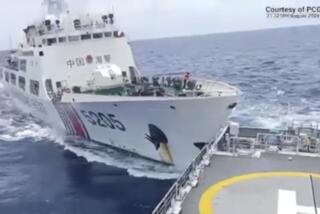As Ordeal Ends for U.S., China’s Hard Part Begins
- Share via
BEIJING — For most Americans, freedom for the crew of a U.S. spy plane marooned in China marked the end of a long, tense diplomatic standoff between Beijing and Washington.
For most Chinese, the work is just beginning.
That’s how the Chinese government Thursday cast the outcome of the 11-day dispute that strained already brittle ties between the world’s sole superpower and its foremost rising power.
Even as China’s state media were selling the result of the confrontation as a victory over the United States, Beijing made it clear that it will not let rest the April 1 collision that forced the U.S. Navy EP-3 reconnaissance plane to land in southern China and a Chinese F-8 fighter jet to crash into the sea.
“This incident is not over,” Chinese Foreign Ministry spokeswoman Zhang Qiyue declared, echoing remarks made by President Jiang Zemin.
Officials said the next act in the diplomatic drama will begin Wednesday at a Sino-U.S. meeting to discuss the midair accident. Beijing plans to repeat its demand that the U.S. military stop intelligence-gathering flights off the Chinese coast, which the Communist regime deems provocative.
The right to publicly air that grievance, one Western analyst said, may have been the most important concession that the Chinese government--and particularly the military--wrung from Washington to end the standoff, beyond U.S. statements of being “very sorry” for the likely death of the fighter pilot.
China will have a platform from which to assert what it sees as its territorial rights to the South China Sea and the airspace above it.
“Now the U.S. side will be dragged into endless discussions with the Chinese side about Chinese waters,” said Jean-Pierre Cabestan, director of the Hong Kong-based French Center for Research on Contemporary China. “They’ll bring it up again and again, and then again.”
Secretary of State Colin L. Powell seemed to resign himself to such continued Chinese demands.
“This is not over,” Powell acknowledged Wednesday amid meetings on the Balkans in Paris. “Some discussions will begin, and we still have our [stranded] plane there [in southern China]. . . . This will all unfold in the days and weeks ahead.”
Spy missions like the one the U.S. Navy aircraft was on when it collided with the Chinese fighter are extremely irksome to Beijing. But the Communist regime, including China’s politically powerful army generals, will probably be disappointed by the U.S. response. National Security Advisor Condoleezza Rice said Thursday that the surveillance flights in Asia are important to preserving U.S. interests and peace in the region.
Nonetheless, Beijing portrayed its settlement with the U.S. over the midair collision as an unalloyed success. The state media described Washington’s expressions of regret as the apology that the Chinese government had demanded, although the Bush administration insists it was no such thing.
The Communist regime made clear that it intended to spin the result as a propaganda ploy to shore up support for its rule.
Thursday’s newspapers in the Chinese capital were filled with articles quoting key segments of society, such as the military and the dreaded People’s Armed Police, praising the Beijing leadership’s handling of the confrontation.
An editorial in the People’s Daily, the Communist Party newspaper, called on residents to harness the passion they showed over the standoff and apply it to building China’s future. “Turn patriotism into national strength,” the newspaper said.
It painted the outcome of the dispute as a moral victory for the Chinese people, who forced “the American government to give up its initial rude and unreasonable attitude.”
In reality, the outcome was a qualified victory for the People’s Liberation Army, which Cabestan said probably pushed for a harder line in Beijing’s negotiations with the U.S.
As a tangible sign that the diplomatic tussle is not over, the PLA still has possession of the damaged EP-3, parked at an airport on Hainan island.
U.S. officials have said that Chinese military experts have probably already stripped the sophisticated plane of whatever equipment remained after the 24 crew members tried to destroy as much as possible before landing.
Beijing asserted its right to hold on to the craft and inspect it, despite Washington’s demands for it to be returned to the U.S.
“That was no ordinary airplane, and therefore it cannot possibly be handled like an ordinary airplane,” Zhang, the Foreign Ministry spokeswoman, told reporters.
Asked if Bush will travel to China in October as previously planned, Zhang said she could not answer for the U.S. leader. Some analysts speculate that President Jiang, who has staked much of his reputation on improving Sino-U.S. ties, finally brought the standoff to an end for fear of jeopardizing Bush’s visit.
And in other unfinished business, the search continued Thursday for the missing Chinese fighter pilot, Lt. Cmdr. Wang Wei, 33, who bailed out over the South China Sea after the collision.
More to Read
Sign up for Essential California
The most important California stories and recommendations in your inbox every morning.
You may occasionally receive promotional content from the Los Angeles Times.














